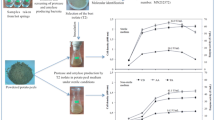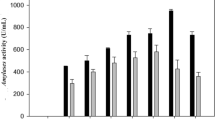Abstract
The amylolytic enzyme production byRhizopus oryzae NRRL 395 grown on different agricultural commodities was datermined. The mould produced much higher enzyme activity from barley, corn, bats, and rice than from cassava. The optimal temperature for enzyme production was 30°C. Neutralization with CaCO3 greatly enhanced the rate of enzyme production. Nitrogen supplementation of cassava resulted in higher enzyme yields.
Résumé
On a déterminé la production d'enzymes amyloytiques parRhizopus oryzae NRRL 395. cultivé sur différents produits agricoies. La moisissure produit une activité enzymatique plus élevée à partir du malt. du maïs, de l'avoine et du riz qu'á partir du manioc. La température optimale pour la production d'enzyme est de 30°C. La neutralisation par al CaCO2 augmente fortement la vitesse de production de l'enzyme. L'ajout d'azote au manioc résulte en un accroissement du rendement enzymatique.
Similar content being viewed by others
References
Anon 1980 Small-scale fuel alcohol production. Washington: U.S. Department of Agriculture.
Berghoffer, E. &Sarhaddar, S. 1988 Production of glucose and high-fructose syrup by enzymatic direct hydrolysis of cassava root.Process Biochemistry 23 (6), 188–194.
Bernfeld, P. 1955 Amylasesa andb.Methods in Enzymology 1, 149–158.
Bradford, M.M. 1976. A rapid and sensitive method for the quantitation of microgram quantities of protein utilizing the principle of protein-dye binding.Analytical Biochemistry 72, 248–254.
ESCOP 1988 Enhanced research agenda for value-added food and non-food uses of agricultural products. Washington:The Experiment Station Committee on Organization and Policy.
Hang, Y.D. 1989 Direct fermentation of corn toL(+)-lactic acid byRbizopus oryzae.Biotechnology Letters 11, 299–300.
Lemmel, S.A., Heimsch, R.C. &Korus, R.A. 1980 Kinetics of growth and amylase production ofSaccharomycopsis fibuligera on potato processing wastewater.Applied and Environmental Microbiology 39, 387–393.
Lin, C.F. 1969 Studies on glucoamylase I. Isolation of a powerful glucoamylase producing strain.Journal of the Chinese Agricultural Chemical Society (Taiwan) 7, 25–30.
Prescott, S.C. &Dunn, C.G. 1959 Industrial Microbiology, 3rd edn. New York: McGraw-Hill.
Raimbault, M. &Alazard, D. 1980 Culture method to study fungal growth in solid fermentation.European Journal of Applied Microbiology and Biotechnology 9, 199–209.
Wang, H.L., Swain, E.W. &Hesseltine C.W. 1975 Mass production ofRhizopus oligosporus spores and their application in tempeh fermentation.Journal of Food Science 40, 168–170.
Wolf, D. 1989 New uses for corn are explained.Finger Lakes Times, Geneva, New York: Jan. 23.
Author information
Authors and Affiliations
Rights and permissions
About this article
Cite this article
Yu, Rc., Hang, Y.D. Amylolytic enzyme production byRhizopus oryzae grown on agricultural commodities. World J Microbiol Biotechnol 6, 15–18 (1990). https://doi.org/10.1007/BF01225348
Received:
Accepted:
Issue Date:
DOI: https://doi.org/10.1007/BF01225348




